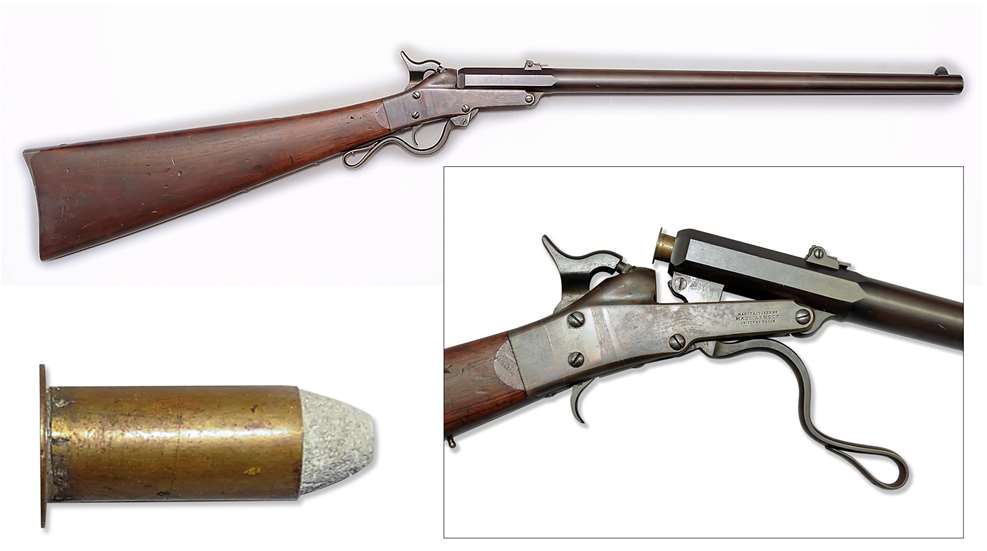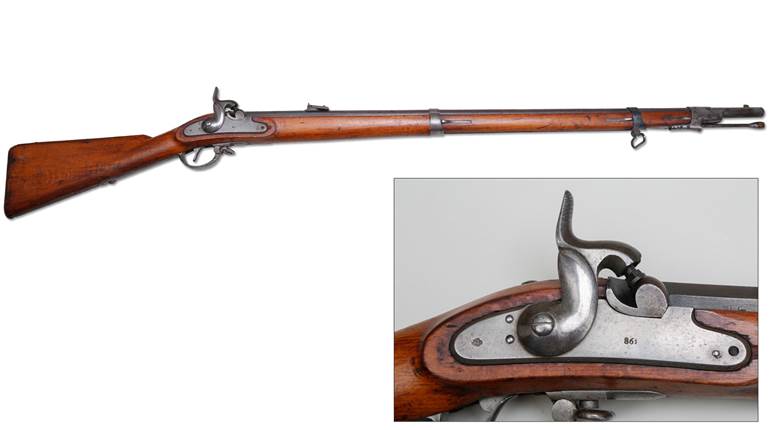
Dr. Edward Maynard listed his principal occupation as “dentist,” and in the mid-to-latter part of the 19th century catered to an elite Washington, D.C. clientele, serving in high-level positions at respected dental institutions. Today, however, he is best known for his achievements in firearm development, Maynard’s mechanical acumen being responsible for garnering some 23 patents in that field.
His first important patent, the Maynard tape primer, was achieved in 1845. This ingenious invention, as its name implied, consisted of a small, laminated paper coil in which was embedded, at regular intervals, dots of mercury fulminate. In arms designed for its use, it was possible, by merely cocking the hammer, to automatically advance a primer on top of a nipple and thus eliminate the awkwardness of having to individually handle small percussion caps.
 As clever as the system was, it did have its faults. While it worked well enough in ideal conditions, it was unfortunately found to become brittle in cold climates and gummy in warm ones. Still, even with these problems, the tape primer was novel enough to be used for a time on commercial rifles, carbines and handguns, along with military arms issued by the U.S. government.
As clever as the system was, it did have its faults. While it worked well enough in ideal conditions, it was unfortunately found to become brittle in cold climates and gummy in warm ones. Still, even with these problems, the tape primer was novel enough to be used for a time on commercial rifles, carbines and handguns, along with military arms issued by the U.S. government.
Six years after his tape primer’s appearance, Dr. Maynard debuted a unique drop-barrel carbine. It was light, simple and easy to operate. One merely lowered a lever to permit the gun’s barrel to tilt downward off the frame and expose the chamber. A proprietary brass cartridge with a wide, thin base, which served to seal the breech, was then inserted and the lever raised to return the barrel to its original position. The cartridge, pierced with a small hole in the base, was ignited by a separate primer on the gun’s exterior nipple. “First Model” Maynard Carbines were, unsurprisingly, fitted with tape primers. After firing, an empty case could be nimbly plucked from the chamber and a new round quickly inserted.
Manufactured by the Massachusetts Arms Co., First Model Maynards, as well as having the tape primers, had butt boxes and folding rear tang sights. Calibers were .35 and .50. Spare shotgun barrels could also be obtained, as the hinging arrangement was so basic that it was an easy matter to swap them over.
In 1857, the U.S. military ordered 400 Maynard Carbines. Tested by both the Army and Navy, the guns received good marks, and a number were subsequently ordered for service. Eventually, some 20,000 were purchased for federal troops during the Civil War, though these .50-cal. ”Second Models” lacked tape primers, butt boxes and tang sights. Interestingly, a quantity of First Models that had been purchased by southern states prior to the Civil War found their way into Rebel hands and, today, are considered secondary Confederate arms.
Weighing but 6 lbs., the Maynard was one of the lightest arms of its type carried by mounted troops during the Civil War. Frames and buttplates were casehardened, and barrels, hammers and levers were blued. The Maynard lacked a fore-end, though this was not unusual during the period, with Cosmopolitan/Gwyn & Campbells, Gallagers and Greenes also built lacking barrel wood. Initially reaching Yankee troops in 1864, Second Model Maynards, though appearing late in the war, were generally well-received by the soldiers.
Unlike many armsmakers who failed after Civil War contracts dried up, as Maynard’s gun was easily modified to handle a self-contained cartridge, his product flourished. Sporting and target rifles ranging in caliber from .22 to .50—some beautifully cased with accessories—enjoyed a healthy business for a number of years thereafter.
The Second Model Maynard Carbine seen here has “1865” marked on its lower tang. This late date is something of a drawback, interest-wise, as it makes it highly unlikely the piece could have seen any Civil War service. Thus, despite its fine shape, value is $2,750.
Gun: Second Model Maynard Carbine
Manufacturer: Massachusetts Arms Co.
Chambering: .50 Maynard
Manufactured: c. 1865
Condition: NRA Excellent (Antique Gun Standards)
Value: $2,750



































